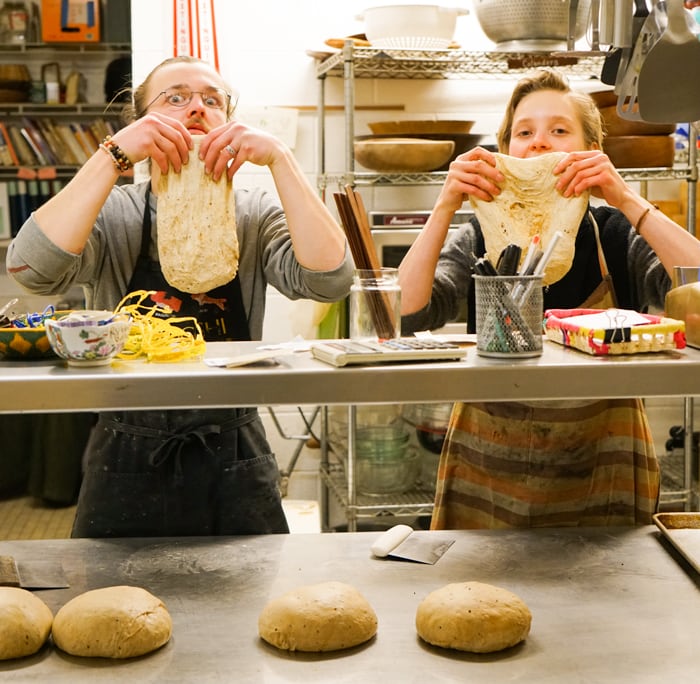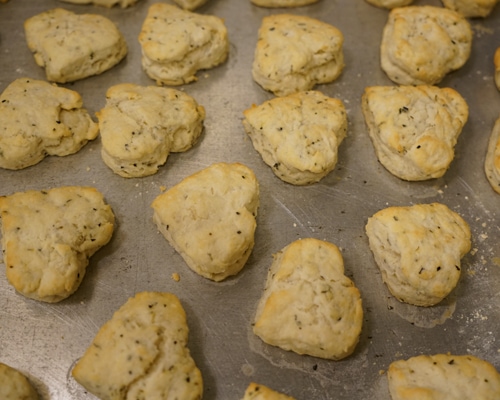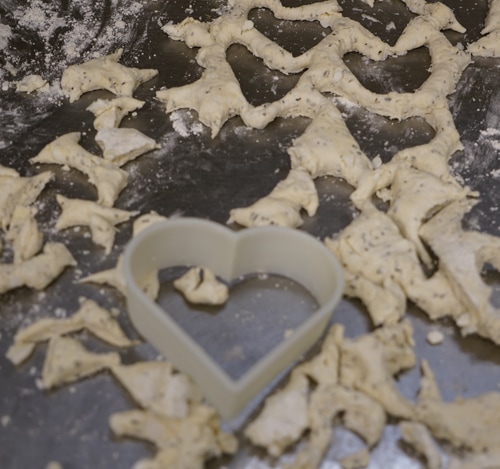As a Southerner, I was raised on the Gospel of Biscuits. As a newbie to the magnificent Pacific Northwest, I’m often stunned to see people manfully spreading butter or margarine and jam on top of biscuits, to order a scone and be served a biscuit, or most puzzling, to see cooks heavily grease a baking sheet in preparation for baking either one. So, here, I share, at least, the Southerner’s take on the difference between these delights, and share a couple of recipes for vegan versions that can easily be passed off as loaded with butter and cream.
Let’s face it, most baked goods consist of the same ingredients—flour, fat, water or milk, and sometimes eggs. (Note: eggs are primarily used in baked goods to extend the shelf life, but that’s a whole other blog post.) Despite this, each has its own enchanting character only when it rises in alignment with its true buddhanature. Combinations of flour, fat, and liquid can be flaky, doughy, chewy, moist, dry, and even creamy. Each has its own food friends and near enemies.

A biscuit is a relative of the pie crust. It aims to be flaky and creamy without a hint of chewiness. The outside should be crisp and golden, and the biscuit should be easily split at the equator when pulled apart in mindful splendor. Inside, the crumb is delicate, moist, and even creamy. A good biscuit rises, but not a great deal. The able baker achieves this wonder by using a very high proportion of fat, by handling the dough very little, by creating a wet dough that still has spring, and by introducing an acid to prevent the gluten in the flour from developing. If one overworks the dough or fully incorporates the fat into the flour, the biscuits will be tough and greasy without flakiness. The delicate flake and crumb of a good biscuit will support a pat of butter than will melt wonderfully or a jam.

An English scone is a relative of the roll or pain au lait. It aims for a sturdier and drier crumb that allows the bread to rise significantly. The outside should be crisp and golden but chewier than a biscuit. It will split easily at the equator when pulled apart, and the interior is marked by horizontal layers. Inside, the crumb is soft, slightly dense, and light. The able baker achieves this delightful pastry by adding some higher gluten flour, cutting down on the fat, and shaping the dough to create the addition of layers. A good English scone will support the addition of fattier toppings such as clotted cream.

Neither pastry benefits from a greased baking sheet. They won’t stick, one, and two, a greasy surface causes the bottom to fry and can ruin the interior texture as well. Cutting a biscuit or scone in half especially when gripped roughly will destroy the texture because it compresses the interior of the bread—in other words, best consumed mindfully.
May you achieve the full buddhanature of your pastry aspirations.
English Scones
200 grams bread flour
300 grams all purpose flour
5 teaspoons baking powder
3/4 teaspoon salt
40 grams vegan margarine, softened and cut in pieces
40 grams non-hydrogenated shortening
80 grams sugar
350 milliliters non-dairy milk
100 grams coconut milk
coconut milk, for glazing
Preheat oven to 425F. In a large bowl, combine the flours, salt, and baking powder. In another bowl, combine the milks and sugar, and whisk together well until the sugar is completely dissolved. Cut the vegan margarine and shortening into dry ingredients. Add the liquid ingredients, and stir to combine. If the dough is dry, add more non-dairy milk until you have a soft, workable dough. When the dough starts to form one mass without a lot of unincorporated flour in the bowl. Dump out onto a floured board. Bring the dough together, working just enough to form one mass, and then, flatten slightly. Then, fold the dough, first folding down the top edge over the middle, then the bottom edge over the middle, and so on with the left and right edges. Turn dough over, and roll out to one inch thick.
Cut the scones with a cutter as desired, and place on an ungreased baking sheet, not touching. Bring together scraps, roll again, and cut, until all dough is used. Brush tops with coconut milk, and sprinkle with sugar.
Bake for 12 to 15 minutes depending on size. This recipes makes 10 large scones or 15 small ones.
Flavoring the Basic Scones Dough
Scones are best flavored with fresh berries, dried fruits, candied ginger, nuts, chocolate chips, or other low moisture goodies. Add approximately 1 to 1 1/2 cups of fruit, nuts, or candies to the flour mixture after cutting in the fat. Then, proceed with forming the dough by adding liquid ingredients
Southern Biscuits

240 grams flour
1 tablespoon baking powder
1 teaspoon sugar
3/4 teaspoon salt
95 grams non-hydrogenated vegetable shortening
2/3 cup non-dairy milk
1 teaspoon apple cider vinegar
1/3 cup light coconut milk
Preheat the oven to 450F. Place the non-dairy milk and coconut milk in a measuring cup, and add the vinegar. Allow to stand while you prepare the dry ingredients. Place all dry ingredients in a bowl, and mix well. Cut the shortening in to the flour mixture until the mixture resembles a coarse meal. Add the soured coconut milk, beginning with about two-thirds of the mixture and adding soured milk as necessary to form a wet dough that holds together in a ball. Do not knead or mix overly as this will develop the gluten and make the texture unpleasant.

Form into a ball, and add a little flour to the outside of the ball if it is sticky. Place the ball on a cutting board, and press flat so that the dough is approximately 3/4” thick. Cut with a small biscuit cutter, and place on an un-greased cookie sheet. Bake for 10-15 minutes depending on size of biscuits. They should be very light golden when done. Serve hot. When you eat them with vegan butter, split the biscuit and place butter on inside. The biscuits should be flaky and split easily without mashing or compressing. If you butter the top, you will destroy the texture of the crust.
Variations:
Herb Biscuits: Add three tablespoons of chopped fresh herbs. A combination of sage and Italian parsley is delicious.
Pepper Biscuits: Add one tablespoon of coarsely ground black pepper to the dry ingredients.

Recipes By: Olivia Walling
